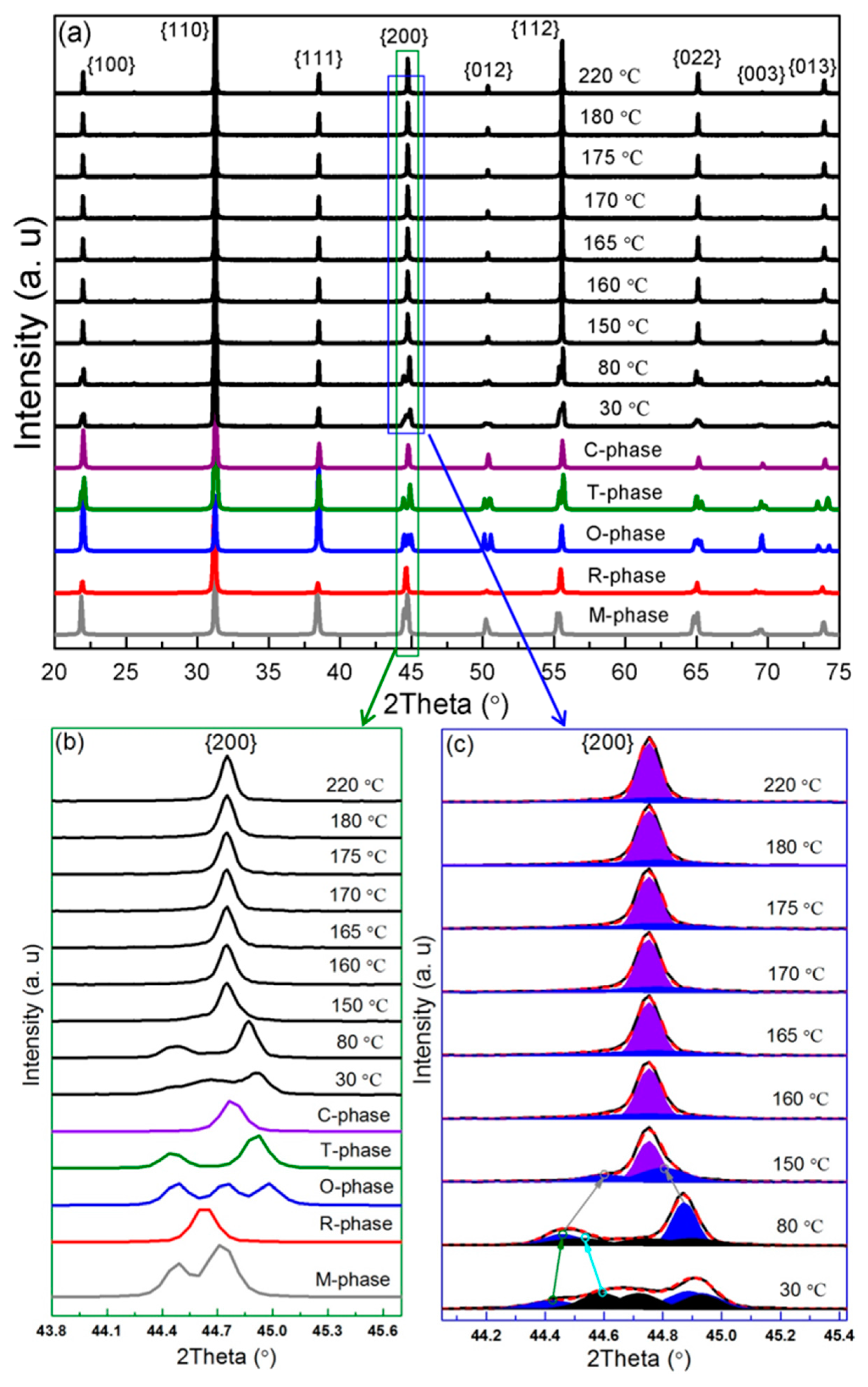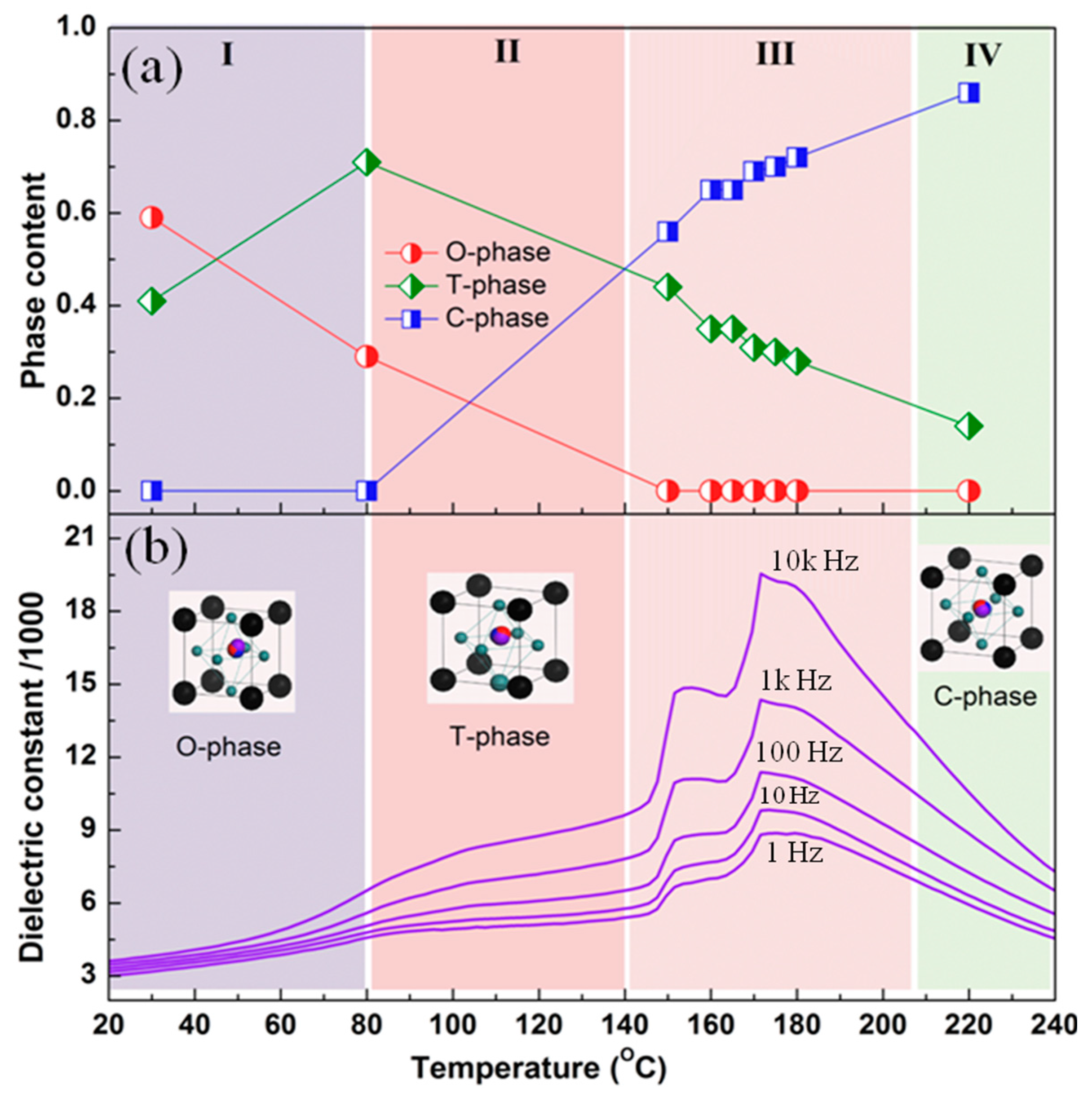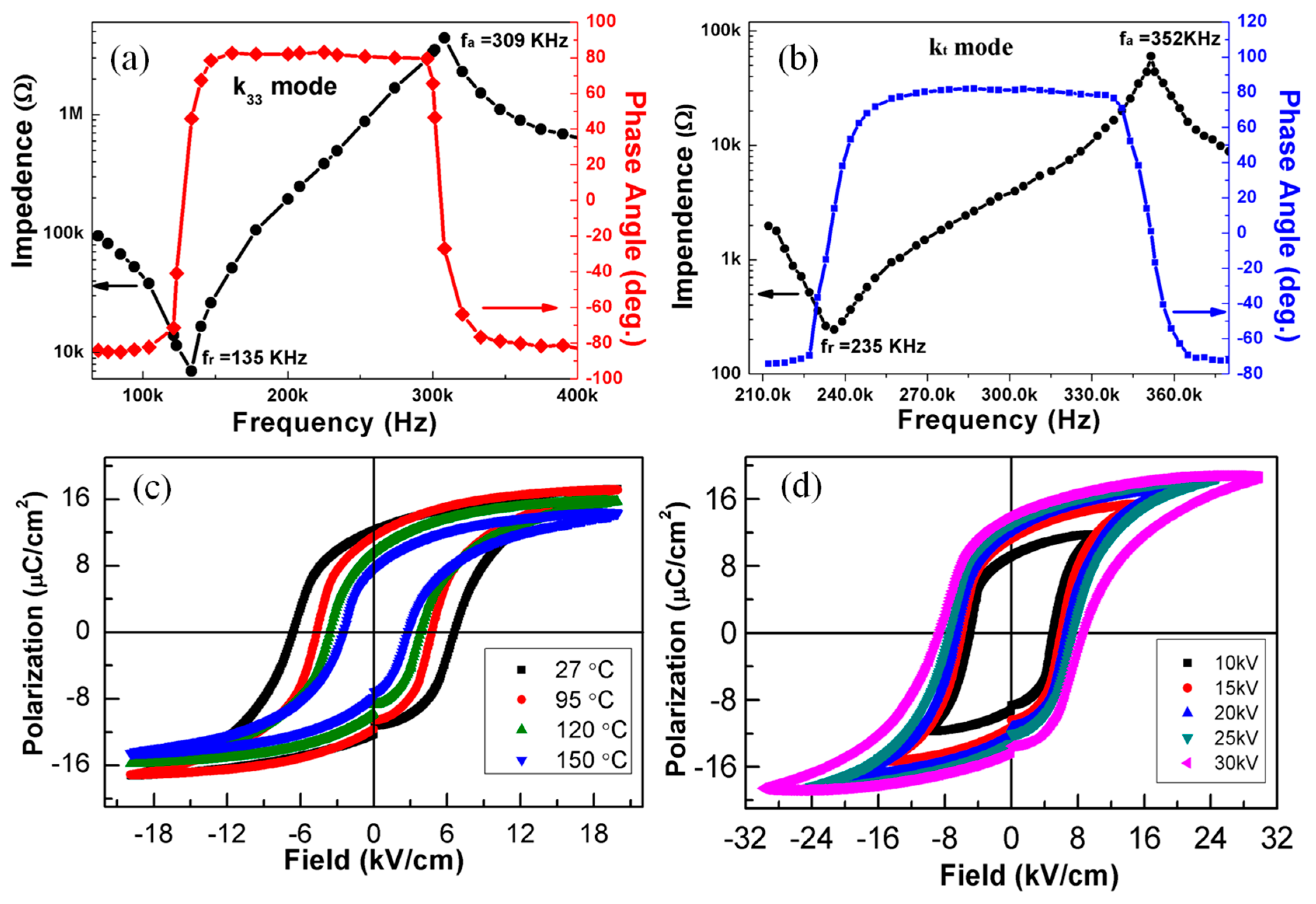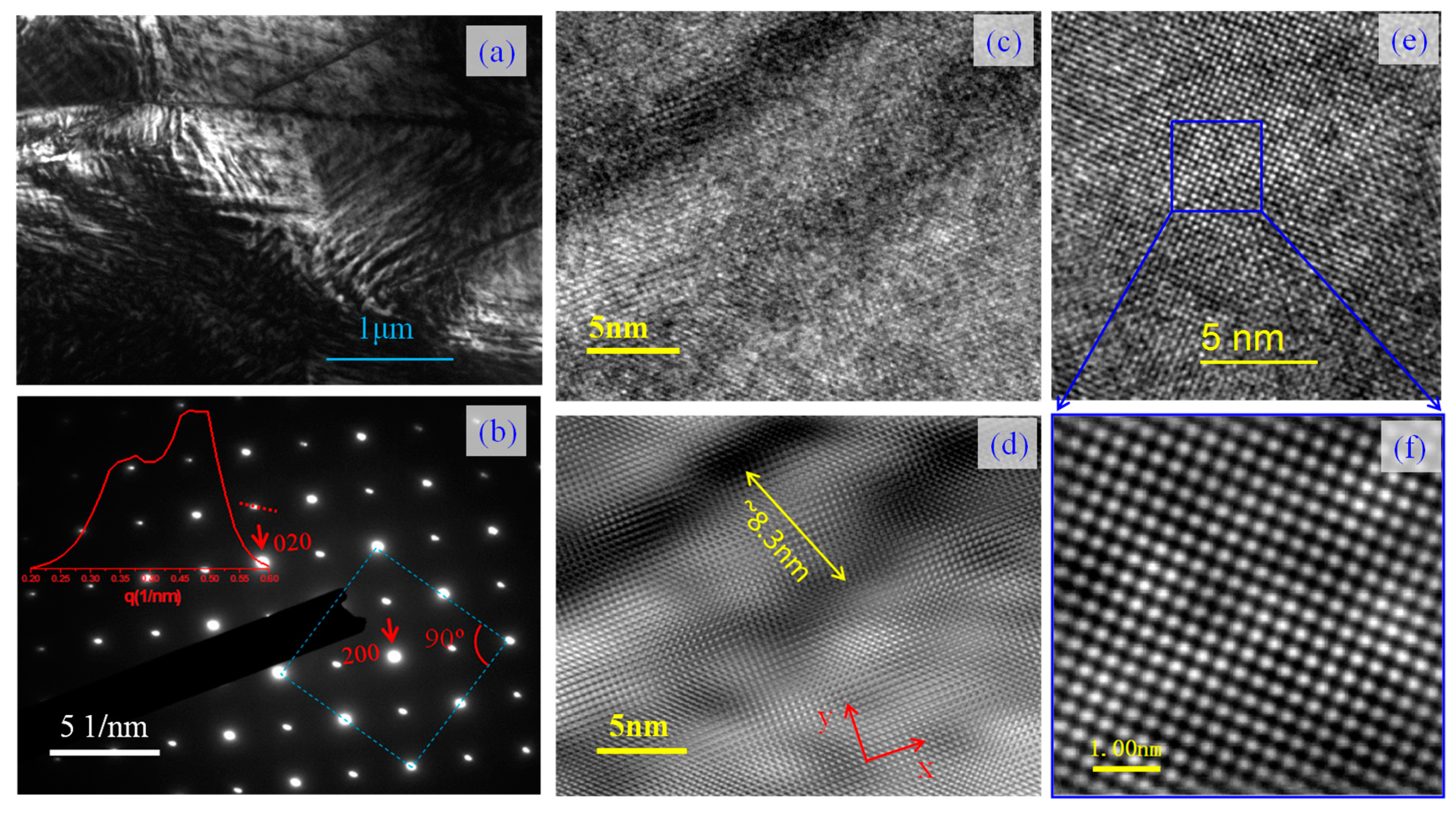A Diagram of the Structure Evolution of Pb(Zn1/3Nb2/3) O3-9%PbTiO3 Relaxor Ferroelectric Crystals with Excellent Piezoelectric Properties
Abstract
:1. Introduction
2. Results and Discussion
2.1. Structure Phase Transition of PZN-9PT Crystals
2.2. Piezoelectric Properties of PZN-9PT Crystals
2.3. Nano Twin Domains of PZN-9PT Crystals
3. Materials and Methods
3.1. Fabrication of PZN-9PT Single Crystal
3.2. Characterization Procedure
4. Conclusions
Acknowledgments
Author Contributions
Conflicts of Interest
References
- Kuwata, J.; Uchino, K.; Nomura, S. Dielectric and piezoelectric properties of 0.91Pb(Zn1/3Nb2/3)O3-0.09PbTiO3 single crystals. Jpn. J. Appl. Phys. 1982, 21, 1298–1302. [Google Scholar] [CrossRef]
- Zhang, S.J.; Li, F.; Jiang, X.N.; Kim, J.; Luo, J.; Geng, X.C. Advantages and challenges of relaxor-PbTiO3 ferroelectric crystals for electroacoustic transducers—A review. Prog. Mater. Sci. 2015, 68, 1–66. [Google Scholar] [CrossRef] [PubMed]
- Sun, E.W.; Cao, W.W. Relaxor-based ferroelectric single crystals: Growth, domain engineering, characterization and applications. Prog. Mater. Sci. 2014, 65, 124–210. [Google Scholar] [CrossRef] [PubMed]
- Zhang, S.J.; Li, F.J. High performance ferroelectric relaxor-PbTiO3 single crystals: Status and perspective. J. Appl. Phys. 2012, 111, 031301. [Google Scholar] [CrossRef]
- Zhang, S.J.; Xia, R.; Lebrun, L.; Anderson, D.; Shrout, T.R. Piezoelectric materials for high power, high temperature applications. Mater. Lett. 2005, 59, 3471–3475. [Google Scholar] [CrossRef]
- Li, T.; Li, X.Z.; Guo, D.; Wang, Z.J.; Liu, Y.; He, C.; Chu, T.; Ai, L.D.; Pang, D.F.; Long, X.F. Phase diagram and properties of high TC/TR−TPb(In1/2Nb1/2)O3-Pb(Zn1/3Nb2/3)O3-PbTiO3 ferroelectric ceramics. J. Am. Ceram. Soc. 2013, 96, 1546–1553. [Google Scholar] [CrossRef]
- Haertling, G.H. Ferroelectric ceramics: history and technology. J. Am. Ceram. Soc. 1999, 82, 797–818. [Google Scholar] [CrossRef]
- Samara, G.A. The relaxational properties of compositionally disordered ABO3 perovskites. J. Phys. Condens. Matter 2003, 15, R367–R411. [Google Scholar] [CrossRef]
- Ye, Z.-G. Crystal chemistry and domain structure of relaxor piezocrystals. Curr. Opin. Solid State Mater. 2002, 6, 35–44. [Google Scholar] [CrossRef]
- Ye, Z.G. Relaxor ferroelectric complex pervoskites: Structure, properties and phase transitions. Key Eng. Mater. 1998, 155, 81–122. [Google Scholar] [CrossRef]
- Janga, H.M.; Kim, S.C. Pb(B′1/2B″1/2)O3-type perovskites: Part І. Pair-correlation theory of order-disorder phase transition. J. Mater. Res. 1997, 12, 2117–2126. [Google Scholar] [CrossRef]
- Wang, Y.J.; Wang, D.; Yuan, G.L.; Ma, H.; Xu, F.; Li, J.F.; Viehland, D.; Gehring, P.M. Fragile morphotropic phase boundary and phase stability in the near-surface region of the relaxor ferroelectric (1–x)Pb(Zn1/3Nb2/3)O3-xPbTiO3: [001] Field-cooled phase diagrams. Phys. Rev. B 2016, 94, 174103. [Google Scholar] [CrossRef]
- Cox, D.E.; Noheda, B.; Shirane, G.; Uesu, Y.; Fujishiro, K.; Yamada, Y. Universal phase diagram for high-piezoelectric perovskite systems. Appl. Phys. Lett. 2001, 79, 400–402. [Google Scholar] [CrossRef]
- He, C.J.; Xu, F.; Wang, J.M.; Liu, Y.W. Refractive index dispersion of relaxor ferroelectric 0.9Pb(Zn1/3Nb2/3)O3-0.1PbTiO3 single crystal. Cryst. Res. Technol. 2009, 44, 211–214. [Google Scholar] [CrossRef]
- Slodczyk, A.; Colomban, P. Probing the nanodomain origin and phase transition mechanisms in (un)poled PMN-PT single crystals and textured ceramics. Materials 2010, 3, 5007–5028. [Google Scholar] [CrossRef]
- Ye, Z.-G.; Dong, M.; Zhang, L. Domain structures and phase transitions of the relaxor-based piezo-/ferroelectric (1–x)Pb(Zn1/3Nb2/3)O3-xPbTiO3 single crystals. Ferroelectrics 1999, 229, 223–232. [Google Scholar] [CrossRef]
- Chang, W.S.; Lim, L.C.; Yang, P.; Ku, C.-S.; Lee, H.-Y.; Tu, C.-S. Transformation stress induced metastable tetragonal phase in (93–92)%Pb(Zn1/3Nb2/3)O3-(7–8)%PbTiO3 single crystals. J. Appl. Phys. 2010, 108, 044105. [Google Scholar] [CrossRef]
- Uesu, Y.; Matsuda, M.; Yamada, Y.; Fujishiro, K.; COX, D.E.; Noheda, B.; Shirane, G. Symmetry of high-piezoelectric Pb-based complex perovskites at the morphotropic phase boundary: I. neutron diffraction study on Pb(Zn1/3Nb2/3)O3-9%PbTiO3. J. Phys. Soc. Jpn. 2002, 71, 960–965. [Google Scholar] [CrossRef]
- Mishra, K.K.; Arora, A.K.; Tripathy, S.N.; Pradhan, D. Dielectric and polarized Raman spectroscopic studies on 0.85Pb(Zn1/3Nb2/3)O3-0.15PbTiO3 single crystal. J. Appl. Phys. 2012, 112, 073521. [Google Scholar] [CrossRef]
- Cheng, J.; Yang, Y.; Tong, Y.H.; Lu, S.B.; Sun, J.Y.; Zhu, K.; Liu, Y.L.; Siu, G.G.; Xu, Z.K. Study of monoclinic-tetragonal-cubic phase transition in Pb(Zn1/3Nb2/3)O3-0.08PbTiO3 single crystals by micro-Raman spectroscopy. J. Appl. Phys. 2009, 105, 053519. [Google Scholar] [CrossRef]
- IEEE Standard on Piezoelectricity: An American National Standard; Institute of Electricity and Electronics Engineers: New York, NY, USA, 1979.
- Zhang, S.J.; Randall, C.A.; Shrout, T.R. Characterization of perovskite piezoelectric single crystals of 0.43BiScO3-0.57PbTiO3 with high Curie temperature. J. Appl. Phys. 2004, 95, 4291–4295. [Google Scholar] [CrossRef]
- Harada, K.; Hosono, Y.; Saitoh, S.; Yamashita, Y. Crystal growth of Pb[(Zn1/3Nb2/3)0.91Ti0.09]O3 using a crucible by the supported Bridgman method. Jpn. J. Appl. Phys. 2000, 33, 3117–3120. [Google Scholar] [CrossRef]
- Jin, Y.M.; Wang, Y.U.; Khachaturyan, A.G.; Li, J.F.; Viehland, D. Conformal miniaturization of domains with low domain-wall energy: Monoclinic ferroelectric states near the morphotropic phase boundaries. Phys. Rev. Lett. 2003, 91, 197601. [Google Scholar] [CrossRef] [PubMed]
- Xu, Z.; Kim, M.; Li, J.F.; Viehland, D. Observation of a sequence of domain-like states with increasing disorder in ferroelectrics. Philos. Mag. A 1996, 74, 395–406. [Google Scholar] [CrossRef]
- Li, T.; Du, Z.H.; Tamura, N.; Lu, W.; Ye, M.; Zeng, X.R.; Ke, S.M.; Huang, H.T. In-situ Synchrotron X-ray Micro-Beam Observation of Phase Transition and Nanotwin Domain Structure in (1–x)PZN-xPT Single Crystals. 2017. in preparation. [Google Scholar]
- Long, X.F.; Ling, J.B.; Li, X.Z.; Wang, Z.J.; Ye, Z.-G. Growth and Di-/Piezoelectric properties of Al-doped PMN-30PT single crystals. Cryst. Growth Des. 2009, 9, 657–659. [Google Scholar] [CrossRef]
- Long, X.F.; Ye, Z.-G. Top-seeded solution growth and characterization of rhombohedral PMN-30PT piezoelectric single crystals. Acta Mater. 2007, 55, 6507–6512. [Google Scholar] [CrossRef]





© 2017 by the authors. Licensee MDPI, Basel, Switzerland. This article is an open access article distributed under the terms and conditions of the Creative Commons Attribution (CC BY) license (http://creativecommons.org/licenses/by/4.0/).
Share and Cite
Zhou, H.; Li, T.; Zhang, N.; Mai, M.; Ye, M.; Lin, P.; Huang, C.; Zeng, X.; Huang, H.; Ke, S. A Diagram of the Structure Evolution of Pb(Zn1/3Nb2/3) O3-9%PbTiO3 Relaxor Ferroelectric Crystals with Excellent Piezoelectric Properties. Crystals 2017, 7, 130. https://doi.org/10.3390/cryst7050130
Zhou H, Li T, Zhang N, Mai M, Ye M, Lin P, Huang C, Zeng X, Huang H, Ke S. A Diagram of the Structure Evolution of Pb(Zn1/3Nb2/3) O3-9%PbTiO3 Relaxor Ferroelectric Crystals with Excellent Piezoelectric Properties. Crystals. 2017; 7(5):130. https://doi.org/10.3390/cryst7050130
Chicago/Turabian StyleZhou, Hua, Tao Li, Nian Zhang, Manfang Mai, Mao Ye, Peng Lin, Chuanwei Huang, Xierong Zeng, Haitao Huang, and Shanming Ke. 2017. "A Diagram of the Structure Evolution of Pb(Zn1/3Nb2/3) O3-9%PbTiO3 Relaxor Ferroelectric Crystals with Excellent Piezoelectric Properties" Crystals 7, no. 5: 130. https://doi.org/10.3390/cryst7050130
APA StyleZhou, H., Li, T., Zhang, N., Mai, M., Ye, M., Lin, P., Huang, C., Zeng, X., Huang, H., & Ke, S. (2017). A Diagram of the Structure Evolution of Pb(Zn1/3Nb2/3) O3-9%PbTiO3 Relaxor Ferroelectric Crystals with Excellent Piezoelectric Properties. Crystals, 7(5), 130. https://doi.org/10.3390/cryst7050130





